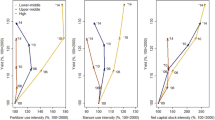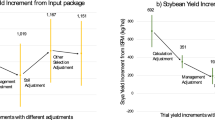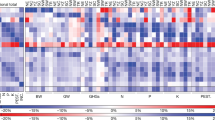Abstract
The Malawian Farm Input Subsidy Programme (FISP) has received praise as a proactive policy that has transformed the nation's food security, yet irreconcilable differences exist between maize production estimates distributed by the Food and Agriculture Organization of the United Nations (FAO), the Malawi Ministry of Agriculture and Food Security (MoAFS) and the National Statistical Office (NSO) of Malawi. These differences illuminate yield-reporting deficiencies and the value that alternative, politically unbiased yield estimates could play in understanding policy impacts. We use net photosynthesis (PsnNet) as an objective source of evidence to evaluate production history and production potential under a fertilizer input scenario. Even with the most generous harvest index (HI) and area manipulation to match a reported error, we are unable to replicate post-FISP production gains. In addition, we show that the spatial delivery of FISP may have contributed to popular perception of widespread maize improvement. These triangulated lines of evidence suggest that FISP may not have been the success it was thought to be. Lastly, we assert that fertilizer subsidies may not be sufficient or sustainable strategies for production gains in Malawi.
This is a preview of subscription content, access via your institution
Access options
Access Nature and 54 other Nature Portfolio journals
Get Nature+, our best-value online-access subscription
$29.99 / 30 days
cancel any time
Subscribe to this journal
Receive 12 digital issues and online access to articles
$119.00 per year
only $9.92 per issue
Buy this article
- Purchase on Springer Link
- Instant access to full article PDF
Prices may be subject to local taxes which are calculated during checkout






Similar content being viewed by others
References
Sanchez, P. A. En route to plentiful food production in Africa. Nat. Plants 1, 14014 (2015).
Chirwa, E. W. & Dorward, A. Agricultural Input Subsidies: The Recent Malawi Experience (Oxford Univ. Press, 2013).
Sachs, J. How Malawi Fed Its Own People (New York Times, 2012).
Denning, G. et al. Input subsidies to improve smallholder maize productivity in Malawi: toward an African green revolution. PLoS Biol. 7, e1000023 (2009).
Malawi – Can It Feed Itself? The Economist (1 May 2008).
Minot, N. & Benson, T. Fertilizer Subsidies in Africa: Are Vouchers the Answer? (International Food Policy Research Institute, 2009).
Ricker-Gilbert, J., Jayne, T. S. & Chirwa, E. Subsidies and crowding out: a double-hurdle model of fertilizer demand in Malawi. Am. J. Agric. Econ. 93, 26–42 (2011).
Chinsinga, B. & Poulton, C. Beyond technocratic debates: the significance and transience of political incentives in the Malawi Farm Input Subsidy Programme (FISP). Dev. Policy Rev. 32, s123–s150 (2014).
Jerven, M. The political economy of agricultural statistics and input subsidies: evidence from India, Nigeria and Malawi. J. Agrar. Chang. 14, 129–145 (2014).
Dorward, A. Evaluation of the 2006/7 Agricultural Input Subsidy Program—Final Report (School of Oriental and African Studies, 2008).
Dorward, A. & Chirwa, E. The Malawi Agricultural Input Subsidy Programme: 2005-6 to 2008-9. Int. J. Agric. Sustain. 9, 232–247 (2011).
Chibwana, C., Fisher, M. & Shively, G. Cropland allocation effects of agricultural input subsidies in Malawi. World Dev. 40, 124–133 (2012).
Chinsinga, B. & O'Brien, A. Planting Ideas: How Agricultural Subsidies are Working in Malawi (Africa Research Institute, 2008).
Jayne, T. S. & Rashid, S. Input subsidy programs in sub-Saharan Africa: a synthesis of recent evidence. Agric. Econ. 44, 547–562 (2013).
Ricker-Gilbert, J., Mason, N. M., Darko, F. A. & Tembo, S. T. What are the effects of input subsidy programs on maize prices? Evidence from Malawi and Zambia. Agric. Econ. 44, 671–686 (2013).
Jayanthi, H. et al. Modeling rain-fed maize vulnerability to droughts using the standardized precipitation index from satellite estimated rainfall—Southern Malawi case study. Int. J. Disaster Risk Reduct. 4, 71–81 (2013).
GIEWS Country Briefs—Malawi (FAO, 2016).
Bastiaanssen, W. G. M. & Ali, S. A new crop yield forecasting model based on satellite measurements applied across the Indus Basin, Pakistan. Agric. Ecosyst. Environ. 94, 321–340 (2003).
Doraiswamy, P. C. et al. Application of MODIS derived parameters for regional crop yield assessment. Remote Sens. Environ. 97, 192–202 (2005).
Reeves, M. C., Zhao, M. & Running, S. W. Usefulness and limits of MODIS GPP for estimating wheat yield. Int. J. Remote Sens. 26, 1403–1421 (2005).
Lobell, D. B. The use of satellite data for crop yield gap analysis. F. Crop. Res. 143, 56–64 (2013).
Peng, D. et al. Modelling paddy rice yield using MODIS data. Agric. For. Meteorol. 184, 107–116 (2014).
MODIS Gross Primary Productivity and Net Photosynthesis (MOD17A2H)—V006 (NASA EOSDIS Land Processes DAAC, 2000).
Running, S., Mu, Q. & Zhao, M. MOD17A2H MODIS/Terra Gross Primary Productivity 8-Day L4 Global 500m SIN Grid V006 (NASA EOSDIS Land Processes DAAC, 2015).
Zhao, M. & Running, S. W. User's Guide—Daily GPP and Annual NPP (MOD17A2/A3) Products—NASA Earth Observing System MODIS Land Algorithm (NASA EOSDIS Land Processes DAAC, 2015).
Zhao, M. S., Heinsch, F. A., Nemani, R. R. & Running, S. W. Improvements of the MODIS terrestrial gross and net primary production global data set. Remote Sens. Environ. 95, 164–176 (2005).
MODIS Net Primary Productivity (MOD17A3)—Version 055 (NASA EOSDIS Land Processes DAAC), 2000).
Production, Area Harvested, and Yield of Maize in Malawi (FAO, 2016).
Crop Production & Area Harvested by Extension Planning Area (Agricultural Production Estimates Survey, MoAFS, 2012).
National Census of Agriculture and Livestock (NACAL) 2006/07—Main Report (NSO Malawi, 2010).
Jayne, T. S., Chapoto, A., Minde, I. J. & Donovan, C. The 2008/09 Food Price and Food Security Situation in Eastern and Southern Africa: Implications for Immediate and Longer Run Responses (Michigan State Univ., 2008).
National Food Security Forecast, April 2013 to March 2014 Bulletin No. 9/13, Vol. 1 (Malawi Ministry of Economic Planning & Development, 2012).
Malawi Facing Serious Food Crisis. FAO (11 August 2005).
Malawi 10-Day Rainfall & Agrometeorological Bulletin (WAMIS, 2005).
Holden, S. & Lunduka, R. Too Poor To Be Efficient? Impacts of the Targeted Fertilizer Subsidy Programme in Malawi on Farm Plot Level Input Use, Crop Choice and Land Productivity (Noragric, 2010).
Rural Malawi Comprehensive Food Security and Vulnerability Analysis (CFSVA) (WFP, 2010).
Malawi Vulnerability Assessment Committee (MVAC) Response Program Report (WFP, 2012).
The Malawi Vulnerability Assessment Committee (MVAC): October 2012 Update Bulletin No. 8, Vol. 2 (MVAC, 2012).
Malawi: Vulnerability Assessment Committee Results (United Nations Office for the Coordination of Humanitarian Affairs, 2015).
Snapp, S., Jayne, T. S., Mhango, W., Benson, T. & Ricker-Gilbert, J. Maize Yield Response to Nitrogen in Malawi's Smallholder Production Systems (International Food Policy Research Institute, 2014).
Mpeketula, P. Soil Organic Carbon Dynamics and Mycorrhizal Fungal Diversity in Contrasting Agroecosystems. PhD thesis, Michigan State Univ. (2016).
Tully, K., Sullivan, C., Weil, R. & Sanchez, P. The state of soil degradation in sub-Saharan Africa: baselines, trajectories, and solutions. Sustainability 7, 6523–6552 (2015).
Tadross, M. et al. Growing-season rainfall and scenarios of future change in southeast Africa: implications for cultivating maize. Clim. Res. 40, 147–161 (2009).
Methods & Standards: Agricultural Production—Crops Primary (FAO, 2016).
Banda, B. B. CountrySTAT for Sub-Saharan Africa—Malawi Panorama Report II—Project GCP/GLO/208/BMG (FAO, 2011).
MODIS Land Cover Type (MCD12Q1)—Version 051 (NASA EOSDIS Land Processes DAAC, 2000).
Land Cover and Land Cover Change of Malawi (1990–2010) (FAO, 2013).
Global Land Cover (GLC) 2000 (ESA, 2005).
GlobCover 2005-06 (ESA, 2008).
GlobCover 2009 (ESA, 2010).
World Land Use—Land Cover (IFPRI, 2002).
Messina, J. et al. Population Growth, Climate Change and Pressure on the Land—Eastern and Southern Africa (Global Center for Food Systems Innovation, 2014).
Establishing Food Security by Improving Maize Production (IFAD); https://www.ruralpovertyportal.org/country/voice/tags/malawi/malawi_foodsecurity
Zhang, H. & Oweis, T. Water–yield relations and optimal irrigation scheduling of wheat in the Mediterranean region. Agric. Water Manag. 38, 195–211 (1999).
Earth Observation System Clearing House (ECHO) (NASA EOSDIS, 2009).
MODIS Reprojection Tool User's Manual—Release 4.1 (USGS Earth Resources Observation and Science Center, 2011).
ArcGIS Desktop Release 10.0–10.2 (Environmental Systems Research Institute, 2014).
Amos, B. & Walters, D. T. Maize root biomass and net rhizodeposited carbon. Soil Sci. Soc. Am. J. 70, 1489 (2006).
Hay, R. K. M. Harvest index: a review of its use in plant breeding and crop physiology. Ann. Appl. Biol. 126, 197–216 (1995).
Brewer, C. et al. Color Brewer v.2.0 (2016); http://www.ColorBrewer2.org
Acknowledgements
We are grateful for the expertise and assistance provided by faculty and staff at the Lilongwe University of Agriculture and Natural Resources (LUANAR) and to those at Africa Rising for facilitating our research in the field. Special thanks to M.N. Kakwera of LUANAR and R. Chikowo of Africa Rising. Additional thanks to L. Liu for assistance with database construction. We also thank the reviewers of this manuscript for their many helpful comments. This work was supported by the Bill & Melinda Gates Foundation under Grant OPP1076311 and through support of the United States Agency for International Development AID-OAA-A-13-00006. The opinions expressed herein are those of the authors and do not necessarily reflect the views of the US Agency for International Development or the US Government.
Author information
Authors and Affiliations
Contributions
J.P.M., B.G.P. and S.S.S. contributed equally to writing and researching this work.
Corresponding author
Ethics declarations
Competing interests
The authors declare no competing financial interests.
Supplementary information
Supplementary Information
Supplementary Figures 1 and 2. (PDF 456 kb)
Rights and permissions
About this article
Cite this article
Messina, J., Peter, B. & Snapp, S. Re-evaluating the Malawian Farm Input Subsidy Programme. Nature Plants 3, 17013 (2017). https://doi.org/10.1038/nplants.2017.13
Received:
Accepted:
Published:
DOI: https://doi.org/10.1038/nplants.2017.13
This article is cited by
-
Exploring agriculture-child nutrition pathways: Evidence from Malawi’s Farm Input Subsidy Program
Food Security (2024)
-
Improving efficiency of knowledge and technology diffusion using community seed banks and farmer-to-farmer extension: experiences from Malawi
Agriculture & Food Security (2022)
-
How to start your monocot CRISPR/Cas project: plasmid design, efficiency detection, and offspring analysis
Rice (2020)
-
Performance, behaviour and organization of maize trading in Malawi
Agricultural and Food Economics (2019)
-
Spatio-temporal analysis of rainfall variability and seasonality in Malawi
Regional Environmental Change (2019)



